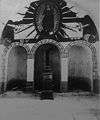Fort Napoleon, Ostend
 Fort Napoleon in Ostend | |
 Location within Belgium | |
| Established | 1811 |
|---|---|
| Location | Ostend, West Flanders, Belgium |
| Coordinates | 51°08′31″N 2°33′57″E / 51.141974°N 2.56596°E |
| Type | Military Museum |
| Nearest car park | On site |
| Website | Website in Dutch and French |
Fort Napoleon in Ostend is a polygonal fort built in the Napoleonic era. It has recently been restored and is open to the public.
France had occupied the Austrian Netherlands (a territory roughly corresponding to the borders of modern Belgium) during 1792 and 1793 in the Flanders Campaign of the French Revolutionary Wars. During the War of the Fifth Coalition, Napoleon Bonaparte expected a British assault from the sea on the port of Ostend, and the fort was constructed in the sand dunes close to the mouth of the harbour in 1811. The British attack never materialised and the fort was used as for troop accommodation and as an arsenal until the end of the French occupation in 1814 when it was abandoned.[1]
During World War I, the fort was used as accommodation for a German headquarters, and decorated with murals by German soldier Heinrich Otto Pieper. The heavy coastal artillery battery "Hindenburg" was stationed nearby; it had been transferred there from Fort Heppen, Wilhelmshaven in 1915, and it was armed with four 280 mm (11 inch) guns of 1886-1887 vintage in heavily armored turrets on semi-circular concrete platforms.[2][3][4] It was captured by the Belgian army in 1918.
The fort was also used as German artillery headquarters during World War II. After the war, it served as a museum and then a children's playground before falling into decay. In 1995, the fort came into the care of Erfgoed Vlaanderen vzw (the Flemish Heritage Association) and following a five year restoration programme, was opened to the public in April 2000.[1]
- Aerial view
 Hindenburg battery in 1918
Hindenburg battery in 1918 German murals inside the fort
German murals inside the fort Mural by Heinrich Otto Pieper, painted during World War I.
Mural by Heinrich Otto Pieper, painted during World War I.
References
- 1 2 "Visitez le Fort Napoléon (French Language)". www.fortnapoleon.be. Herita Open Monuments. Retrieved 5 December 2015.
- ↑ (Dutch) G. Billiet, "De Duitse Batterijen Op De Belgische Kust In 1914-1918. Beknopt Overzicht", in O. Villain, Tijdschrift van de Oostendse Heemkundige Kring "De Plate", 12 December 1984.
- ↑ The Yser And The Belgian Coast. Illustrated Michelin Guided to the Battle-Fields (1914-1918). 1920. p. 72. OL 7044675M.
- ↑ Aleks A. M. Deseyne (1997). "The German Coastal Defense in Flanders, 1914-1918". In Steven Weingartner. A weekend with the Great War: proceedings of the Fourth Annual Great War Interconference Seminar, Lisle, Illinois, 16–18 September 1994. White Mane Pub. pp. 42–43. ISBN 978-1-57249-062-8.
[...] Outmoded guns were transferred with their crews from positions on the German coast (Wilhelmshaven and Kiel) to Flanders. For example, the Hindenburg battery, originally located at Fort Heppen near Wilhelmshaven and equipped with 28cm dating from 1886, was transferred to Ostend, where its guns were installed exactly as they had been in their former positions.
External links
| Wikimedia Commons has media related to Fort Napoleon (Ostend). |
- Website in Dutch and French.
- History in Dutch by the Flemish Heritage Institute (nl:Vlaams Instituut voor het Onroerend Erfgoed)
Coordinates: 51°14′19.74″N 2°56′5.96″E / 51.2388167°N 2.9349889°E